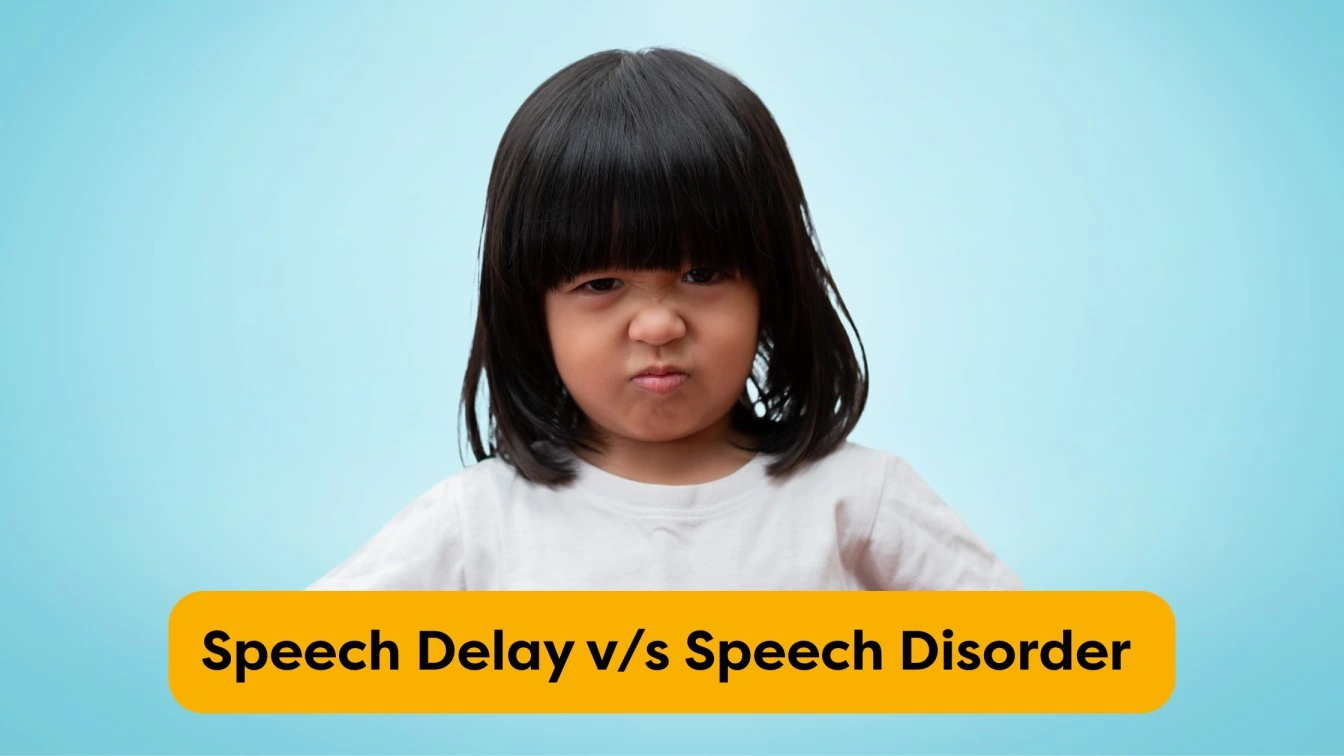Most toddlers start saying simple words, such as “mama” or “dada,” around 12 months and begin combining words by 18 to 24 months. Speech delay is when a child takes longer than usual to start speaking or using words. It does not always mean something is wrong; sometimes kids just develop at their own pace. But spotting it early and giving the right support can help.
According to a survey, over 40% of the parents report noticing a speech delay in children under five. Research also shows that speech and language delays persist in 40–60% of cases, where children face a higher risk of emotional-social and learning disabilities later in life.
Understanding Speech Delay in Toddlers

Speech delay is not just about late talking; it can also mean difficulty in forming clear words, building sentences, or even understanding the language. Speaking challenges in the early years can sometimes lead to learning or social difficulties later. As many toddlers face speech issues, giving attention to it early by promoting toddler speech delay activities can make a big difference in their future.
Recognizing Signs of Speech Delay in Toddlers
| Age | Typical Speech Milestones | Potential Red Flags |
| 12 months | Babbles with different sounds, responds to their name, turns towards familiar voices | Limited babbling, no response to name, no interest in sounds or voices |
| 18 months | Uses single words (mama, dada, baba), understands simple instructions, and points to objects | No single words by 18 months, difficulty understanding simple instructions, limited gestures |
| 2 years | Combines two words into phrases, asks simple questions (“What’s that?”), follows basic instructions | No word combinations by 2 years, difficulty expressing needs or wants, limited vocabulary |
| 3 years | Uses sentences of 3-4 words, tells short stories, and asks more complex questions (“Why is the tree green?”) | Difficulty forming sentences, limited understanding of complex instructions, and frustration with communication |
The Difference Between a Delay and a Disorder

Delay:
When a child develops speech skills in the standard sequence, such as babbling, saying single words, and blending two or more words, but at a slower rate than expected for their age. He is still progressing, just later than other toddlers.
Disorder:
When a child shows unusual patterns in communication, such as difficulty forming sentences, trouble understanding language, or being unable to express themselves due to limited vocabulary, and may not follow the expected sequence of development. Unlike a delay, a disorder often requires more intensive and expert intervention.
No matter where your child is on their speech journey, the right steps can make huge progress. Let us look at 10 simple activities to support toddlers with speech delay.
10 Effective Toddler Speech Delay Exercises

1. Regular Play
One of the most effective ways to support speech development is through regular playtime. Use this opportunity to label toys to build word recognition. Mention the toy by the label name when you play with it. Instruct him to address the toy by its label. It will help your child with memorization and vocabulary.
2. Reading
Read picture books with your kids. Picture books with bright and engaging illustrations will entertain and introduce them to new words and ideas. While reading, pause to ask simple questions or leave out predictable words, like animal sounds, to encourage your child to participate. At first, they may get distracted, but with time, they’ll get familiar with enjoying the reading process. It can boost language development, problem-solving, attention span, and imagination.
3. Learning Colours
Children learn to distinguish colours after 18 months. Start with the basic colours like red, blue, green, and yellow. Incorporate colours into daily conversations. Say things like “Bring me the red apple” or “Where’s the blue pillow?” Repetition through everyday use is the key to helping toddlers master colours naturally. This activity boosts colour recognition, creativity, and memory.
4. Learning Sign Language
Toddlers may use the same sounds for different needs, like hunger, thirst, or other requests. When adults are unable to interpret, children get distressed. Teaching basic sign language can help bridge communication skills by giving them a way to express themselves clearly.
Basic signs for words like more, help, eat, drink, come, go, or sleep will give your child a sense of control and reduce frustration. Over time, these gestures make way for more confident verbal communication.
5. Singing Songs
Singing songs or nursery rhymes is a powerful way to boost your child’s speech development. Toddlers love music and movement, making it easier for them to engage and learn. While you are singing, stop and let your child say the next word so that he can join in. The rhythm and repeating words in songs help children remember and understand words better. Repeating phrases in rhymes reinforces vocabulary, improves pronunciation, and supports memory.
6. Self-Talk Practice
It is merely narrating your actions out loud in front of your child. For example, while peeling a potato, you might say, “I’m peeling a potato,” or if you’re thirsty, say, “I’m going to drink some water because I’m thirsty.” This simple habit helps your child develop better listening skills and encourages them to mimic your words, gradually improving their speech.
7. Parallel Talk
It is one of the most popular speech therapy games for toddlers. It is narrating your actions out loud in front of your child. For example, if your child is bouncing a ball, say, “Ball bouncing” or “Big ball.” If he is near a chair, say “Chair” or “White chair.” Use short, clear phrases to match your child’s attention span. This helps them connect words to actions and encourages speech through observation and repetition.
8. Contingency Therapy
This activity uses small rewards to encourage your child to modify behaviour. This is especially helpful when toddlers have a hard time following instructions. If a kid insists on playing, link that activity with something that you want them to do, for example, “First we read this book, then you can play,” or “Finish lunch, then it’s playtime.” This activity will make it easier for your child to understand and act according to directions.
9. Picture Flashcards
Flashcards with images of everyday objects are a great way to build your child’s vocabulary, word recognition, and memory. Hold up a card, name the object, and encourage your child to repeat it. You can turn it into a game by matching cards, sorting them by category of animals, food, shape, or colours, or asking your child to find the object around the house.
10. Role-Playing
Involve your child in playing interactive pretend games like playing a doctor treating a patient, a shopkeeper selling an item to a customer, cooking together in a play kitchen, pilot and passenger, or teacher teaching a student. These scenarios encourage your child to naturally use their brain to learn new words, ask questions, and respond accordingly.
The Do’s and Don’ts of At-Home Speech Practice

1. When To Practice?
- Do pick a time when your child is calm and alert (like after sleep or food).
- Don’t force practice when they’re tired, hungry, or cranky.
2. How Long To Practice?
- Do keep sessions short, like 5 to 10 minutes at a time.
- Don’t practice too long. It can make your child lose interest.
3. What To Practice?
- Do use everyday activities, mealtime, bath time, or playtime, to practice words.
- Don’t stick only to flashcards or drills. Make it fun and interactive.
4. What To Look For When You Practice?
- Do notice how your child responds. If they are attempting to copy sounds or imitate words, praise every effort.
- Don’t correct harshly. Gently repeat the correct word instead.
FAQs
1. What are some language activities for toddlers?
Singing songs, reading books, and talking about what you’re doing to your toddler will build their vocabulary. Use naming games, flashcards, and pretend play to keep it playful. Simple instructions and basic sign language also help boost understanding and expression. To discover more language activities, visit KLAY.
2. How do I help my 2-year-old with speech therapy?
A 2-year-old learns best through talking, singing, dancing, and playing, not through structured lessons. Trying to teach complex sentences and words they don’t understand can confuse them and won’t help with their speech delay. Use the age-appropriate toddler speech therapy games mentioned above to keep learning fun and natural.
3. How can I help my toddler with speech therapy at home?
Keep your toddlers involved in your daily activities. Let them watch and listen as you talk to your family, a shopkeeper, or a neighbour. They learn a lot from your words, tone, and expressions. Celebrate small wins, like when they use the right word at the right time. Most importantly, be patient as it will give them the confidence to keep trying.
















Subscribe to our newsletter
[contact-form-7 id="12706" title="Newsletter Form for post page"]Our Related Blogs
Yoga Benefits, Activities, and Poses for Preschoolers
For preschoolers, yoga isn’t about perfection but about giggles and benefits. So, are you curious how a simple stretch can support a child’s focus, flexibility, and emotional well-being? Let’s roll...
Year-End Reflection and Goal Setting for Children
Parenting is a journey filled with the brightest moments and valuable lessons, both for us and our children. As the year draws to a close, it’s the perfect time to...
Why Parents Trust KLAY Preschools in Sector 65 Gurgaon
Finding the right preschool and daycare in Gurgaon can feel overwhelming. Parents look for a place that is safe, nurturing, and focused on holistic development. KLAY Preschool and Daycare in...